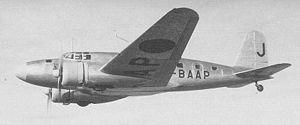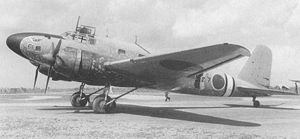Mitsubishi Ki-57 Video - Picture

|
|
Mitsubishi Ki-57
Ki-57

Picture - MC-20-I, with a nickname Asagumo (morning cloud), used by Asahi Shimbun.
Role: Transport aircraft
Paratroop Transport
Passenger aircraft
Manufacturer: Mitsubishi Jukogyo Kabushiki Kaisha (Mitsubishi Heavy Industries Limited)
Designed by: Mitsubishi Jukogyo KK Design Team
First flight: August 1940
Introduction: 1942
Primary user: Imperial Japanese Army Air Force
Imperial Japanese Navy Air Service
Imperial Japanese Airways
Produced: 1940-1945
Number built: 406
Developed from: Mitsubishi Ki-21
The Mitsubishi Ki-57 was a Japanese passenger transport aircraft, developed from the Ki-21 bomber, during the early 1940s.
Development

Picture - MC-20-II with a nickname Hakutsuru(white crane) of the China Airlines during the Sino-Japanese war.
In 1938, when the Ki-21 heavy bomber began to enter service with the Imperial Japanese Army, its capability attracted the attention of the Imperial Japanese Airways. In consequence a civil version was developed and this, generally similar to the Ki-21-I and retaining its powerplant of two 708 kW (950 hp) Nakajima Ha-5 KAI radial engines, differed primarily by having the same wings transferred from a mid to low-wing configuration and the incorporation of a new fuselage to provide accommodation for up to 11 passengers. This transport version appealed also the navy, and following the flight of a prototype in August 1940 and subsequent testing, the type was ordered into production for both civil and military use.
This initial production Ki-57-I had the civil and military designations of MC-20-I and Army Type 100 Transport Model 1, respectively. A total of 100 production Ki-57-Is had been built by early 1942, and small numbers of them were transferred for use by the Japanese navy in a transport role, then becoming redesignated L4Ml. After the last of the Ki-51s had been delivered production was switched to an improved Ki-57-II, which introduced more powerful 805 kW (1,080 hp) Mitsubishi Ha-l02 14-cylinder radial engines installed in redesigned nacelles and, at the same time, incorporated a number of detail refinements and minor equipment changes. Civil and military designations of this version were the MC-20-II and Army Type 100 Transport Model 2, respectively. Only 406 were built before production ended in January 1945. Both versions were covered by the Allied reporting name "Topsy".
Variants
Ki-57-I Army Type 100 Transport Model 1: Powered by two 708 kW (950 hp) Nakajima Ha-5 KAI radial engines and a redesigned fuselage to accommodate 11 passengers. About 100 aircraft of this type were built including the civil version.
MC-20-I: Same as above but built for civil use with Imperial Japanese Airways (Dai Nippon Koku KK).
Ki-57-II Army Type 100 Transport Model 2:Powered by two 805 kW (1,080 hp) Mitsubishi Ha-l02 14-cylinder radial engines installed in redesigned nacelles. Minor equipment and detail refinements were also incorporated. 306 aircraft of this type were produced before the end of production in January 1945.
MC-20-II: Same as above but built for civil use with Imperial Japanese Airways (Dai Nippon Koku KK).
L4M1: A small number of Ki-57-IIs were transferred for use by the Japanese navy as transports and were redesignated L4M1.
Operators
Wartime
Japan
Imperial Japanese Army Air Force
Imperial Japanese Navy Air Service
Imperial Japanese Airways
Post-war
China
The last Ki-57 was used as a trainer and retired in 1952.
Japan
Imperial Japanese Airways (till October 1945)
Netherlands
Captured aircraft, used by the KNIL.
Specifications (Ki-57-II)
Data from Japanese AIrcraft of the Pacific War
General characteristics
Crew: 4 (pilot, co-pilot, navigator and radio operator)
Capacity: 11 passengers
Length: 16.10 m (52 ft 9â
in)
Wingspan: 22.60 m (74 ft 1¾ in)
Height: 4.86 m (15 ft 11â
in)
Wing area: 70.08 m² (754.3 ft²)
Empty weight: 5,585 kg (12,313 lb)
Loaded weight: 8,173 kg (18,018 lb)
Max takeoff weight: 9,120 kg (20,106 lb)
Powerplant: 2x Mitsubishi Ha-102 Zuisei 14-cylinder air-cooled radial engine, 805 kW (1,080 hp)(at take-off) each
Performance
Maximum speed: 470 km/h (254 kn, 292 mph) at 5,800 m (19,000 ft)
Range: 3,000 km (1,622 nmi, 1,865 mi)
Service ceiling: 8,000 m (26,250 ft)
Wing loading: 116.6 kg/m² (23.9 lb/ft²)
Climb to 5,000 m (16,400 ft): 15 min 45 s
Related development
Mitsubishi Ki-21
Bibliography
Francillon, Ph.D., René J. The Mitsubishi Ki-21 (Aircraft in Profile number 172). Leatherhead, Surrey, UK: Profile Publications Ltd., 1967.
Francillon, Ph.D., René J. Japanese Aircraft of the Pacific War. London: Putnam & Company Ltd., 1970. ISBN-0-370-00033-1 (2nd edition 1979, ISBN 0-370-30251-6; 3rd edition 1987 by Putnam Aeronautical Books, 1987. ISBN 0-85177-801-1).
Mitsubishi Ki-57 Pictures
Living Warbirds: The best warbirds DVD series.
Source: WikiPedia